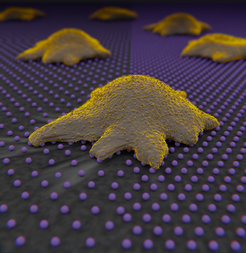Research News: How cells feel their environment

The interaction between cells and their ligands (or cellular microenvironment), e.g. through receptors, is essential to maintain the function of any tissue. In fact, the detection of changes in the cellular environment is fundamental in any scenario where tissue remodeling occurs: embryonic development, wound healing, or tumor proliferation. Until now, it was thought that cells somehow ‘measure’ distances, which led to the hypothesis that there must be some type of ‘standard’ molecule to help them do this. The collaborative work performed by the team of Ada Cavalcanti-Adam, head of the central scientific facility “Cell Biotechnology” at the MPI for Medical Research and research group leader at the Heidelberg University, together with the team of Pere Roca-Cusachs, Institute for Bioengineering of Catalonia in Barcelona, contradicts this.
“In previous studies, we could already show that there is a close relationship between receptor clustering and mechanical tension in cells and that this is finely regulated at receptor-ligand binding sites,” explains Ada Cavalcanti-Adam. “We were able to determine how cells adjust forces depending on the position of molecules (or ligands) in their environment on a nanometer scale,” says Tina Wiegand, second author of the paper and PhD student in Ada’s lab at the Max Planck Institute for Medical Research. "To allow such a small-scale analysis, we developed specific substrates were we can place ligands at designated distances and vary the stiffness of the material," explains Tina Wiegand further. When the cells adhere to those ligands, they apply a force they sense. As the force depends on the spatial distribution of the ligands, this allows the cells to feel their surroundings. Collaborator Pere Roca-Cusachs compares this to “recognizing somebody’s face in the dark by touching it with your hand, rather than seeing the person”.
The researchers also saw that “depending on the distribution of cellular forces, the activation of genetic transcription is affected – the phenomenon that determines which genes are expressed,” according to Roger Oria, first author of the study and a PhD student in Pere’s lab.
With this more integrated knowledge of how cells detect their surroundings, the researchers have found that by modifying the conditions of the cell environment (the rigidity and distribution of the ligands that make up the extracellular matrix), the adhesion response of the cell can be controlled, even as far as defining the range within which the cell adheres at all.
As, for example, tumor cells need to actively adapt their structure to a changing environment as they migrate, understanding the process of sensing their surroundings can help to determine and manipulate the behavior of those cells.
The work also involved researchers at the Institute for Bioengineering of Catalonia (IBEC), the Instituto de Investigación en Ingeniería de Aragón of the University of Zaragoza and Heidelberg University. It was funded by the European Commission, MINECO, the Generalitat de Catalunya, the European Research Council, the “La Caixa” Foundation, La Marato de TV3 and the German Science Foundation (DFG) SFB1129.
(Vienna Leigh, Elisabeth Fuhry)
